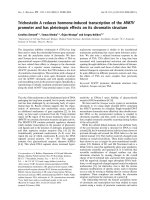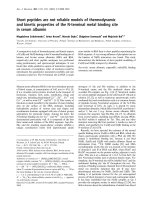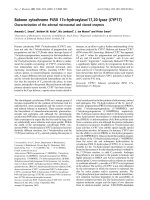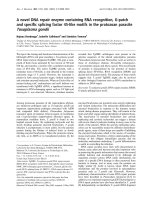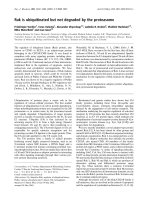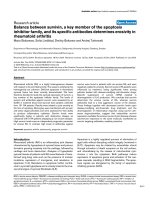Báo cáo Y học: Baboon cytochrome P450 17a-hydroxylase/17,20-lyase (CYP17) Characterization of the adrenal microsomal and cloned enzymes docx
Bạn đang xem bản rút gọn của tài liệu. Xem và tải ngay bản đầy đủ của tài liệu tại đây (558.2 KB, 9 trang )
Baboon cytochrome P450 17a-hydroxylase/17,20-lyase (CYP17)
Characterization of the adrenal microsomal and cloned enzymes
Amanda C. Swart
1
, Norbert W. Kolar
1
, Nic Lombard
1
, J. Ian Mason
2
and Pieter Swart
1
1
Department of Biochemistry, University of Stellenbosch, South Africa;
2
Department of Reproductive & Developmental Sciences,
University of Edinburgh Medical School, Scotland, UK
Human cytochrome P450 17a-hydroxylase (CYP17) cata-
lyses not only the 17a-hydroxlation of pregnenolone and
progesterone and the C17,20-side chain cleavage (lyase) of
17a-hydroxypregnenolone, necessary for the biosynthesis of
C
21
-glucocorticoids and C
19
-androgens, but also catalyses
the 16a-hydroxylation of progesterone. In efforts to under-
stand the complex enzymology of CYP17, structure/func-
tion relationships have been reported previously after
expressing recombinant DNAs, encoding CYP17 from
various species, in nonsteroidogenic mammalian or yeast
cells. A major difference between species resides in the lyase
activity towards the hydroxylated intermediates and in the
fact that the secretion of C
19
-steroids take place, in some
species, principally in the gonads. Because human and higher
primate adrenals secrete steroids, CYP17 has been charac-
terized in the Cape baboon, a species more closely related to
humans, in an effort to gain a further understanding of the
reactions catalysed by CYP17. Baboon and human CYP17
cDNA share 96% homology. Baboon CYP17 has apparent
K
m
and V values for pregnenolone and progesterone of
0.9 l
M
and 0.4 nmolÆh
)1
Æmg protein
)1
and 6.5 l
M
and
3.9 nmolÆh
)1
Æmg protein
)1
, respectively. Baboon CYP17had
a significantly higher activity for progesterone hydroxyla-
tion relative to pregnenolone. No 16a-hydroxylase and no
lyase activity for 17a-hydroxyprogesterone. Sequence ana-
lyses showed that there are 28 different amino acid residues
between human and baboon CYP17, primarily in helices F
and G and the F-G loop.
Keywords: CYP17; baboon; cytochrome P450; 17a-
hydroxylase; 17, 20-lyase.
The steroidogenic cytochromes P450 are a unique group of
enzymes responsible for the synthesis of hormones vital for
reproduction, stress management and the control of water
and mineral balance in mammals. These enzymes catalyse
the biosynthesis of mineralocorticosteroids, glucocortico-
steroids and androgens and although the steroidogenic
cytochromes P450 share acommon reaction mechanism with
their counterparts in organs like the liver and the lung, they
are substantially more substrate and organ specific. Within
the ambit of the steroidogenic cytochromes P450, cyto-
chrome P450 17a-hydroxylase (CYP17) catalyses at least two
distinctly different reactions, the 17a-hydroxylase and the
17,20-lyase reactions, of C
21
-steroids, placing this enzyme at
a key branch point in the biosynthesis of aldosterone, cortisol
and androgens. The 17a-hydroxylation of the D
5
-andD
4
-
steroids, pregnenolone (PREG) and progesterone (PROG),
yields 17a-hydroxypregnenolone (17-OHPREG) and
17a-hydroxyprogesterone (17-OHPROG), respectively.
The 17,20-lyase reaction cleaves the C17,20 bond converting
these hydroxylated intermediates to dehydroepiandroster-
one (DHEA) or androstenedione (A4). Both activities arise
from a common active site although the precise mechanism
of catalysis is not known. In addition to 17-hydroxylase and
lyase activities, CYP17 also exhibits species specific steroid
hydroxylase activities. In humans, for instance, CYP17 also
has the ability to convert PROG to 16a-hydroxyprogester-
one (16-OHPROG) [1]. Glucocorticoid biosynthesis requires
the release of the 17a-hydroxylated product, 17-OHPROG,
from the active site and subsequent hydroxylation by
cytochrome P450 21-hydroxylase (CYP21). It is, however,
possible for the 17a-hydroxylated intermediate to remain
bound to the enzyme or for the released product to rebind for
the 17,20-lyase reaction, to yield C
19
-steroids. Androgen
biosynthesis is not restricted to the gonads in humans and
higher primates as DHEA and A4 are synthesized by the
adrenal gland. Lower vertebrates such as rodents are unable
to synthesize adrenal C
19
-steroids as CYP17 is not expressed
in the adrenal. The activity of CYP17 is not only influenced
by the environment in which the enzyme is expressed, but
also by redox partner and/or accessory proteins. The
17a-hydroxylation/lyase reactions are standard mixed-func-
tion oxidation reactions dependent on the accessibility of
electron transport proteins [2]. The hydroxylation reaction
requires molecular oxygen and the input of two electrons
from its electron-transfer partner, FAD/FMN-dependent
Correspondence to A. C. Swart, Department of Biochemistry,
University of Stellenbosch, Private Bag X1, Matieland, 7602,
South Africa. Fax: + 27 21 8085863, Tel.: + 27 21 8085862,
E-mail:
Abbreviations: PROG, progesterone; 17-OHPROG, 17a-hydroxy-
progesterone; 16-OHPROG, 16a-hydroxyprogesterone; PREG,
pregnenolone; 17-OHPREG, 17a-hydroxypregnenolone; 3b-HSD,
3b-hydroxysteroid dehydrogenase/D5-D4 isomerase; A4, 4-andros-
tene-3,17-dione; DEPC, diethylpyrocarbonate; DHEA, dehydro-
epiandrosterone; DHEA-S, dehydroepiandrosterone-sulphate; DOC,
deoxycorticosterone; CYP17, cytochrome P450 17a-hydroxylase;
CYP21, cytochrome P450 21-hydroxylase; CYP11A, cytochrome
P450 side chain cleavage; CYP11B1, cytochrome P450 11b-hydroxy-
lase; ACTH, adrenocorticotrophic hormone.
Enzymes: cytochrome P450 17a-hydroxylase (CYP17) EC 1.14.99.9.
(Received 6 July 2002, revised 5 September 2002,
accepted 18 September 2002)
Eur. J. Biochem. 269, 5608–5616 (2002) Ó FEBS 2002 doi:10.1046/j.1432-1033.2002.03268.x
NADPH-cytochrome P450 reductase. The production of
C
19
androgen precursors from the 17a-hydroxy intermedi-
ates involves another two rounds of mono oxygenation. The
availability of reducing equivalents enhances the lyase
activity of CYP17 and it would appear that high expression
levels of cytochrome b
5
also increases the biosynthesis of
androgens in some species [3,4].
The dual activity of CYP17 and the differential regulation
thereof have been the subject of many studies. It is apparent
that the normal expression and dual hydroxylase and lyase
activities of this key enzyme are essential for normal
metabolic and reproductive activities in all mammals,
including man. There appears to be only one form of
CYP17, encoded by a single gene, expressed in both the
adrenals and gonads [5]. Mutations in the human gene result
in the loss of a functional protein eliminating, in some
clinical cases, only the 17,20-lyase activity [6] or both the
17a-hydroxylase and 17,20-lyase activities [7,8]. Cyto-
chrome P450 17a-hydroxylase deficiency is characterized
by impaired cortisol production resulting in the hypersecre-
tion of ACTH and an increased biosynthesis of deoxycor-
ticosterone (DOC) and corticosterone. The absence of lyase
activity in humans results in the development of abnormal
secondary sex characteristics, sexual infantilism in females
and failure of virilization in males [7,9].
As CYP17 has not been crystallized, most information
about the structure/function relationship of this hemopro-
tein has been obtained from comparative studies between
different species, analysis of the CYP17 gene of individuals
with CYP17 deficiency as well as from homology align-
ments with bacterial cytochromes P450 [10]. The degree of
amino acid sequence homology between cytochromes P450
of humans and other species ranges from 48 to 71%,
resulting in the prediction of domains playing a catalytic
role rather than specific amino acids. The hydroxylase
activity of CYP17 for the D
5
-andD
4
-steroids is quite similar
across species, but notable differences exist in the ability of
the enzyme to cleave 17-OHPREG and 17-OHPROG.
Human and bovine CYP17 catalyse the hydroxylation
of both PREG and PROG and the conversion of
17-OHPREG to DHEA but lyase activity for the 17-OH-
PROG intermediate is negligible [11,12]. The hydroxylase
and lyase activity of guinea pig CYP17 favours the
D
4
-steroid pathway, the enzyme being incapable of meta-
bolizing 17-OHPREG to DHEA [13]. Rat, porcine and
hamster CYP17 catalyse the D
4
and D
5
hydroxylase and
lyase reactions, yielding both DHEA and A4 [14–16].
The alignment of mammalian cytochromes P450 with
bacterial cytochromes P450 has allowed the prediction of
domains involved in substrate binding and redox partner
interaction [10,17]. Although site-directed mutageneses and
naturally occurring CYP17 mutants have pinpointed specific
amino acid residues playing an essential role in structure/
function relationship of CYP17, interspecies homology
alignments of CYP17 have been less effective in structure/
function analysis [18]. The characterization of baboon
cytochrome CYP17 would allow comparative studies of
human CYP17 with a species much more closely related than
investigated thus far, and may contribute to a further
understanding of the hydroxylase and lyase activities of the
enzyme in relation to substrate binding and orientation.
PROG and 17-OHPROG metabolism was investigated in
baboon adrenal microsomes to determine the catalytic
properties of baboon CYP17 in the presence of the compet-
ing CYP21 enzyme and of membrane components including
NADPH-cytochrome P450 reductase, cytochrome b
5
and
phospholipids. The gene encoding baboon CYP17 was
isolated from baboon adrenal mRNA. The recombinant
DNA was expressed in nonsteroidogenic cells and the K
m
and V values of the expressed enzyme were determined.
MATERIALS AND METHODS
Animals
Adrenal glands and blood were obtained from normal adult
Cape baboons. Baboon adrenal tissue was obtained from
the animal units housed at the University of Cape Town
Medical School and the University of Stellenbosch Medical
School. All anaesthetic and surgical procedures were
approved by the Animal Research and Ethics committee
of the two Universities and complied with the ÔPrinciples of
Laboratory CareÕ and the ÔNIH Guide for the Care and Use
of Laboratory AnimalsÕ 1996. Adrenal glands, allocated for
RNA isolation, were flash frozen and stored in liquid N
2
.
For all experiments material was collected from 20 groups
consisting of between two and four baboons over a period
of eight years. All the experiments to be described were
carried out on at least three different groups of adrenals.
Reagents
[
3
H]PROG, [
3
H]17-OHPROG, DHEA and A4 were pur-
chased from Amersham Life Science (Amersham, Bucks,
UK) and [
3
H]PREG from Dupont New England Nuclear
(Boston, MA, USA). Antibiotics, NADPH and diethyl-
aminoethyl-dextran were purchased from Sigma Chemical
Co. (St Louis, MO, USA). Bacterial culture media were
purchased from Difco Laboratories (Detroit, MI, USA)
and tissue culture media from Gibco-BRL (Gaithersburg,
MD, USA). Plasmid vectors, restriction enzymes, T4
Ligase, Taq DNA polymerase were purchased from
Promega Bioteck (Madison, WI, USA) and ribonucleotide
triphosphates from Boehringer Mannheim Biochemicals
(Mannheim, Germany). All other chemicals were of reagent
grade purchased from scientific supply houses.
Determination of the cytochromes P450 and
b
5
contents of baboon adrenal microsomes
Microsomes were prepared from baboon adrenal cortex
homogenate using standard differential centrifugation tech-
niques [19]. The cytochrome P450 and cytochrome b
5
content of baboon adrenal microsomes were determined as
previously described [20]. An extinction coefficient of
100 cm
)1
Æm
M
)1
was used for the determination of the
cytochrome P450 content while an extinction coefficient of
185 cm
)1
Æm
M
)1
was used to determine the concentration of
the cytochrome b
5
[20,21].
Assay for steroid metabolism in baboon adrenal
microsomes
The metabolism of PROG and 17-OHPROG was assayed
as previously described [22]. Adrenal microsomes (0.5 l
M
P450) were pre incubated with [
3
H]PROG and PROG
Ó FEBS 2002 Characterization of baboon CYP17 (Eur. J. Biochem. 269) 5609
(10 l
M
)inatotalvolumeof0.5mLfor5minat37 °C. The
reaction was initiated by the addition of NADPH
(11 nmol). An aliquot (50 lL) of the reaction mixture was
removed prior immediately to the addition of NADPH and
subsequently at 2-min intervals. The same protocol was
followed to assay 17-OHPROG metabolism in baboon
adrenal microsomes. Steroids were extracted with dichloro-
methane (10 volumes), the dichloromethane phase was
evaporated under N
2
and the dried residue redissolved in
methanol prior to HPLC analysis.
Separation and quantification of steroids
Chromatography was performed on a Waters (Milford,
MA, USA) high performance liquid chromatograph cou-
pled to a WISP
TM
automatic injector (Waters) and a Flo-
One liquid scintillation spectrophotometer (Radiomatic,
Tampa, FL). PROG metabolites were separated on a
NovapakÒ C
18
column at a flow rate of 1 mLÆmin
)1
.The
mobile phase consisted of solvent A (water/methanol 45/55)
and solvent B (100% methanol). The column was eluted for
15 min with solvent A, followed by a linear gradient from
100% A to 100% B in 10 min and an isocratic elution with
solvent B for 10 min PREG and 17OH-PREG metabolites
were separated on a NovapakÒ C
8
column at a flow rate of
1mLÆmin
)1
. The mobile phase consisted of solvent A
(water/acetonitrile/isopropanol, 50 : 48.5 : 1.5, v/v/v) and
solvent B (100% acetonitrile). The column was eluted for
5 min with solvent A, followed by a linear gradient from
100% A to 100% B in 2 min and an isocratic elution with
solvent B for 3 min.
RNA isolation and reverse transcriptase-polymerase
chain reaction (RT-PCR)
Total RNA was extracted from baboon adrenal cortex with
guanidinium thiocyanate followed by centrifugation in a
cesium chloride solution [23]. Polyadenylated RNA (poly
A
+
) RNA was isolated using a mRNA Capture kit
(Boehringer Mannheim Biochemicals). Complementary
cDNA was synthesized by reverse transcription of mRNA
using the Titan
TM
One Tube RT-PCR system (Boehringer
Mannheim Biochemicals). The reverse transcription reac-
tion was performed at 50 °Cfor30minafterwhich
thermocycling was carried out directly. Baboon specific
primers, complementary to the 3¢-and5¢-termini of baboon
CYP17, 5¢-tagtctcgagtactgtctatcttgcctgctga-3¢ (sense), and
5¢-tatacccgggaagcttttaggtgctaccctcagcctg-3¢ (antisense) were
used. The RT-PCR product was gel purified, digested with
XhoI and cloned into a mammalian expression vector, pCI-
neo, previously digested with XhoIandSmaI. Nucleotide
sequences of both strands, purified RT-PCR product and
cloned cDNA, were determined using the Bigdye
TM
Version
2 diterminator sequencing kit (model 373 A ABI, Applied
Biosystems, Foster City, CA).
Assay of CYP17 enzyme activity in
HEK-293 cells
HEK-293 cells, grown in Dulbecco’s modified Eagle’s
medium (DMEM), containing 0.9 gÆL
)1
glucose, 0.12%
NaHCO
3
, 10% fetal bovine serum, 1% penicillin-strepto-
mycin were transfected with the pCI-neo/baboon CYP17
construct, 5 lgÆmL
)1
, using diethylaminoethyl-dextran,
0.25 mgÆmL
)1
, with the later addition of 100 l
M
chloro-
quine [24]. The same protocol was followed to determine the
catalytic activity of the recombinant human enzyme, using
pcD CYP17 [24]. Control transfection reactions were
carried out with the plasmid vector pCIneo. After 72 h
steroidogenic precursors were added to the cells with the
appropriate tritium-labelled steroid substrate, [
3
H]PROG
and [
3
H]PREG. Aliquots of 0.5 mL, were removed at
specific time intervals and the steroid metabolites were
extracted with dichloromethane and analysed by HPLC as
described above. Immediately after the completion of each
experiment, the cells were washed with NaCl/P
i
, collected in
the same buffer and homogenized with a small glass
homogeniser. The protein content of the homogenate was
subsequently determined by the Bradford method [25].
RESULTS
Concentrations of cytochrome P450 and cytochrome
b
5
in baboon adrenal microsomes
The dithionite reduced carbon monoxide vs. oxidized
difference spectrum of baboon adrenal microsomal cyto-
chrome P450 is given in Fig. 1A. The peak at 425 nm,
indicative of cytochrome b
5
, is reduced upon the addition of
NADH to the reference cuvette (Fig. 1B). The NADH
reduced vs. oxidized difference spectrum of baboon adrenal
microsomes is given in Fig. 1C. The spectrum with a
maximum at 424 nm and a minimum at 409 nm is charac-
teristic of cytochrome b
5
[20]. The concentration of baboon
adrenal cytochrome P450 was 0.55 nmolÆmg
)1
microsomal
protein and the concentration of cytochrome b
5
was 0.17 nmolÆmg
)1
protein.
Fig. 1. Carbon monoxide dithionite reduced
vs. oxidized difference spectrum of baboon
adrenal microsomal cytochrome P450. (A)
Before the addition and (B) after the addition
of NADH to the reference cuvette. The
reduction in the peak at 425 nm after addi-
tion of NADH is indicative of the presence of
cytochrome b
5
. (C) NADH reduced vs.
oxidized difference spectrum of ovine adrenal
microsomes. The maximum at 424 nm and a
minimum at 404 nm is indicative of cyto-
chrome b
5
.
5610 A. C. Swart et al. (Eur. J. Biochem. 269) Ó FEBS 2002
CYP17 activity in adrenal microsomes
A progression curve for the metabolism of PROG by a
baboon adrenal microsomal preparation is shown in Fig. 2.
At 2 min 65% of the PROG had been metabolized, yielding
40% 17-OHPROG and 10% each of deoxycortisol and
DOC. After 12 min the PROG was depleted with deoxy-
cortisol accounted for more than 50% of the radiolabelled
metabolites. DOC accounted for 27.5% of the metabolites
indicating that the 17a-hydroxylase activity was consider-
ably higher than the 21-hydroxylase activity. Typical HPLC
analyses of PROG metabolites present in the medium at 4
and 15 min, respectively, are shown in Fig. 3A and B. A4
and 16a-hydroxyprogesterone were not detected. The
metabolism of 17-OHPROG by baboon adrenal micro-
somes (Fig. 4) showed that at 5 min 50% of the
17-OHPROG was converted to deoxycortisol, the only
product, no A4 was detected in the medium.
Characterization of baboon CYP17 cDNA
RT-PCR amplification of baboon mRNA, using baboon
specific primers complementary to the nucleotide sequence
encoding the amino and carboxy terminal of baboon
Fig. 2. Metabolism of PROG (10 l
M
) by baboon adrenal microsomes
(0.5 l
M
P450).
Fig. 3. HPLC analyses of products of PROG
metabolism (10 l
M
) by baboon adrenal
microsomes at 4 min (A) and at 15 min (B).
Peaks on the chromatogram are: 1, PROG
(25.75 min); 2, 17-OHPROG (14 min); 3,
DOC (11 min); and 4, deoxycortisol
(6.5 min).
Fig. 4. Metabolism of 17-OHPROG (10 l
M
) by baboon adrenal
microsomes (0.5 l
M
P450).
Ó FEBS 2002 Characterization of baboon CYP17 (Eur. J. Biochem. 269) 5611
CYP17 (GenBank accession no. AY 034635), yielded a
single 1524 bp product which was cloned and sequenced.
The nucleotide sequence (GenBank accession no. AF
297650) showed 96% homology with human CYP17
cDNA and encodes for a predicted 508 amino acid
protein. The 28 amino acid differences between baboon
and human CYP17 are predominantly conservative with
some differences resulting in a change in side chain size and
polarity. Exon 3 and 4 show the least homology between the
baboon and human sequence. Significant changes include
three positively charged residues K196, H199 and R234
which correspond to polar residues in the human sequence
and the two larger aromatic residues, F218 and F247, in the
baboon sequence which correspond to S and L in the
human sequence. In exon 7 there is another positively
charged residue H391 corresponding to E in the human
sequence.
CYP17 activity in HEK-293 cells transfected
with pCI-neo/baboon CYP17 cDNA
The activity of baboon CYP17 was determined in HEK-293
cells transfected with pCI-neo/baboon CYP17 cDNA.
Expression of the recombinant enzyme permitted the
investigation of the catalytic activity for PREG and PROG
away from the competitive influence of 3b-HSD and
CYP21. Metabolism of PREG and PROG by human
CYP17 was also determined to allow comparison of human
and baboon CYP17 in the same HEK-293 cellular envi-
ronment.
The conversion of PREG by baboon CYP17 expressed in
HEK-293 cells yielded 17-OHPREG and DHEA (Fig. 5).
Initially no DHEA was detected prior to 50% of the PREG
being converted to the 17-hydroxy intermediate. After 13 h
more than 90% of the PREG was metabolized,
17-OHPREG and DHEA being the major metabolites.
The conversion of PREG to 17-OHPREG and DHEA by
human CYP17 (Fig. 6) proceeded at a similar conversion
rate although the initial accumulation of 17-OHPREG
before DHEA formation was observed, was not as
pronounced as that seen for the conversion of PREG by
baboon CYP17. A comparison of the ratios of
DHEA:17-OHPREG formation during PREG metabolism
indicated that the biosynthesis of DHEA was initially
slower for baboon CYP17 than for the human enzyme.
(Fig. 7). The K
m
and V values for PREG utilization by
baboon CYP17 were 0.9 l
M
and 0.45 nmolÆh
)1
Æmg
)1
pro-
tein, respectively (Fig. 8). These values did not differ
significantly from the values obtained for human CYP17
under the same circumstances (Table 1).
The metabolism of PROG by baboon CYP17 expressed
in HEK-293 cells yielded only 17-OHPROG (Fig. 9).
PROG metabolism by human CYP17 expressed under the
same conditions, yielded 17-OHPROG, 16a-hydroxypro-
gesterone but no A4 (Fig. 10). The ratio of 17-OHPROG to
16a-hydroxyprogesterone was approximately 4 : 1 as pre-
viously reported for expression in COS 1 cells [1]. The K
m
for PROG utilization by baboon CYP17 expressed in HEK-
293 cells, was 6.5 l
M
and the maximum velocity (V value)
was 3.9 nmolÆh
)1
Æmg
)1
protein (Fig. 11). As reflected in the
V value of the two enzymes, HEK-293 cells expressing
baboon CYP17 utilized PROG at a higher rate than
HEK-293 cells expressing human CYP17.
Fig. 5. Time course of PREG (1 l
M
) metabolism by baboon CYP17
expressed in HEK-293 cells.
Fig. 6. Time course of PREG (1 l
M
) metabolism by human CYP17
expressed in HEK-293 cells.
5612 A. C. Swart et al. (Eur. J. Biochem. 269) Ó FEBS 2002
The K
m
and V values for PROG and PREG utilization
by the expressed cytochromes CYP17, are summarized in
Table 1.
DISCUSSION
Cytochromes CYP17 from various species display distinctly
different catalytic activities, unique to their physiological
requirements. These differences, in which specific metabolic
routes in the steroidogenic pathway are favoured, yielding
different levels of steroid production, can be attributed to
the species-specific hydroxylase and lyase activities of
CYP17 for PREG, PROG and the hydroxylated interme-
diates. The expression of the recombinant enzyme from
various species in nonsteroidogenic systems has led to the
characterization of CYP17 at enzymatic and molecular
levels [26,27]. In the absence of a crystal structure these
investigations have contributed to a better understanding of
structure/function relationships and comparative analyses
between different species have identified specific domains
and amino acid residues crucial to the catalytic activity of
the enzyme. The interspecies differences, however, make it
difficult to extrapolate nonprimate and rodent data on
steroid metabolism in primates and subsequently complicate
deductions pertaining to structure/function relationships.
Our report describes the molecular and enzymatic charac-
terization of CYP17 in the Cape baboon, a species closely
related to humans. Baboon CYP17 encodes a deduced
protein of 508 amino acid residues exhibiting, in primary
structure, 96% sequence similarity to that of human
CYP17. Baboon CYP17 exhibited distinct differences and
Table 1. Summary of kinetics of PROG and PREG metabolism by baboon CYP17 expressed in HEK-293 cells. For each substrate concentration,
initial reaction rates of PROG and PREG utilization were determined at various substrate concentrations by linear regression. At least five time
points were used for each rate determination and in the cases where a slight lag phase was observed, only the linear part of the curve was used. The
R-squared value for all initial rate regression analyses was always higher than 0.98. K
m
values are the mean ± SEM of three experiments.
Progesterone Pregnenolone
Species K
m
(l
M
) V (nmolÆh
)1
Æmg protein
)1
) K
m
(l
M
) V (nmolÆh
)1
Æmg protein
)1
)
Baboon 6.5 ± 0.1 3.9 0.9 ± 0.05 0.45
Human 0.8 ± 0.1 0.5 1.3 ± 0.2 0.5
Fig. 7. Ratio of 17-OHPREG and DHEA formation during PREG
(1 l
M
) metabolism by baboon and human CYP17 expressed in HEK-293
cells.
Fig. 8. Kinetics of PREG metabolism by baboon CYP17 expressed in
HEK-293 cells. Apparent K
m
¼ 0.9 l
M
; V value ¼ 0.45
nmolÆh
)1
Æmg
)1
protein. Results are representative of at least three
independent experiments.
Ó FEBS 2002 Characterization of baboon CYP17 (Eur. J. Biochem. 269) 5613
similarities to human CYP17 in the catalytic activity,
making the baboon an important CYP17 candidate for
the study of structure/function relationships.
CYP17 is a membrane-bound microsomal cytochrome
P450. In the adrenal gland the activity of this enzyme is
influenced, not only by the cellular lipid environment, but
also by the presence of electron transport proteins,
cytochrome P450 reductase and cytochrome b
5
.Inaddi-
tion 3b-HSD competes with CYP17 for the same
substrates, PREG and 17-OHPREG, while CYP21 com-
petes with CYP17 for PROG and 17-OHPROG. Our
experiments with baboon adrenal microsomes enabled the
investigation of baboon CYP17 activity in the physiolo-
gical environment of the endoplasmic reticulum. In the
baboon adrenal microsomal preparations, the PROG
17-hydroxylase activity was considerably higher than the
PROG CYP21 activity as indicated by the 3 : 1 ratio of
the metabolites, deoxycortisol to DOC after all the PROG
had been utilized. In contrast, CYP17 and CYP21 of
human fetal adrenal microsomes exhibited comparable
hydroxylase activities for PROG [1]. Furthermore, human
CYP17 catalysed the formation of 16-OHPROG, a
metabolite not detected during the metabolism of PROG
by baboon CYP17. A4 was also not detected as a product
of PROG metabolism indicating that baboon CYP17, like
human CYP17, has little, if any, lyase activity towards
17-OHPROG. Cytochrome b
5
, a modulating agent of
CYP17 activity, was present in the baboon adrenal
Fig. 9. Time course of PROG (1 l
M
) metabolism by baboon CYP17
expressed in HEK-293 cells. Insert: HPLC analyses of PROG meta-
bolism (1 l
M
) by baboon CYP17 expressed in HEK-293 cells. Peaks
on the chromatogram are: 1, PROG (20.5 min); 2, 17-OHPROG
(17.25 min). No 16-OHPROG or A4 was detected.
Fig. 10. Time course of PROG (1 l
M
) metabolism by human CYP17
expressed in HEK-293 cells.
Fig. 11. Kinetics of PROG metabolism by baboon CYP17 expressed in
HEK-293 cells. (apparent K
m
¼ 6.5 l
M
; V value ¼ 3.9 nmolÆh
)1
Æmg
)1
protein). Results are representative of at least three independent
experiments.
5614 A. C. Swart et al. (Eur. J. Biochem. 269) Ó FEBS 2002
microsomal preparations and the ratio of cytochrome
P450 to cytochrome b
5
was 3:1.
A comparison between the microsomal baboon CYP17
investigated in this study and human microsomal CYP17
previously reported [1], suggested similarities as well as
differences in the functional activities of the enzyme in these
two species. Neither enzyme had lyase activity towards
PROG or 17-OHPROG but human CYP17 could convert
PROG to 16-OHPROG while the baboon enzyme could
not. To further investigate these findings the cDNA
encoding baboon CYP17 was subsequently expressed in
HEK-293 cells. PREG metabolism by baboon CYP17
expressed in HEK-293 cells, did not differ significantly from
human CYP17 expressed in the same system and the
apparent K
m
and V values for the two enzymes with PREG
as substrate, did not show a notable difference (Table 1).
The conversion of PREG to DHEA, however, appears to
differ with respect to the interaction of the enzyme with the
17-hydroxylated intermediate. Baboon CYP17 initially
converted most of the PREG to 17-OHPREG and during
the entire experiment, the ratio of DHEA/17-OHPREG
was lower than for the human enzyme while PREG was still
available as substrate (Fig. 7). In comparison, human
CYP17 metabolizes 17-OHPREG at a significantly faster
rate in the presence of PREG and the DHEA/17-OHPREG
is higher for the human CYP17 throughout the 12 h
incubation period (Fig. 7). These results indicate that
PREG could potentially have a greater influence on the
lyase activity of baboon CYP17 than on the human enzyme
and that human CYP17 possibly converts a greater
percentage of bound 17-OHPREG to DHEA. It may well
be that the 17-hydroxylated intermediate is less tightly
bound to the baboon enzyme and a greater percentage of
the 17-OHPREG will therefore leave the active site. Clearly
this aspect needs to be studied further as it has an important
bearing on the ability of the baboon to produce adrenal
C19-steroids, particularly if the baboon is producing high
levels of cortisol.
In contrast to PREG metabolism, baboon CYP17
expressed in HEK-293 cells converted PROG to
17-OHPROG much faster than the human enzyme
(Table 1). The higher V value obtained for the baboon
enzyme could be attributed to a higher expression level than
the human enzyme due to differences in expression vectors
used. It is, however, not apparent how differences in the
expression levels could result in the differences observed
in the apparent K
m
values obtained (Table 1). In addition
it is important to note that the same differences were
not observed for the metabolism of PREG by the two
enzyme preparations. Despite the large degree of homology
between the human and baboon CYP17 the expressed
baboon CYP17 was unable to catalyse the formation of
16a-hydroxyprogesterone. Both expressed enzymes had no
lyase activity towards PROG or 17-OHPROG.
Understanding of the complexity of hydroxylase and
lyase activity of CYP17 by way of primary sequence
alignments of CYP17 from different species has limitations.
Even though CYP17 homology ranges from 65 to 78%,
making deductions pertaining to structure/function rela-
tionships, using interspecies primary sequence alignments,
has been hampered due to the variation in catalytic activities
amongst species. A combination of computational model-
ling and structural alignments with bacterial cytochromes
P450 has identified domains in the primary sequence of
human CYP17 which are involved in the catalytic activity of
the enzyme, i.e. substrate docking and binding, the active
site including the heme-binding domain and redox partner
binding domain [10]. Baboon and human CYP17 are
excellent candidates for identifying regions in the primary
sequence that contribute to substrate specificity, affinity and
binding. The two species share 96% sequence similarity in
primary sequence yet baboon CYP17 seemingly has a
considerably higher apparent K
m
for PROG and no 16a-
hydroxylase activity.
Sequence alignments of CYP17 based on the structures of
bacterial cytochromes P450 (according to the alignment of
Graham-Lorence [10]) show that the most significant
differences in the primary sequences of human and baboon
CYP17 lie in the predicted substrate access and binding
regions which include helices F and G and the F-G loop.
The differences between the two species in the F and G helix
and F-G loop could alter substrate affinity by tighter
binding and the larger hydrophobic residues could change
the shape of the active pocket. It was shown by Beaudoin
et al. that guinea pig CYP17 preferentially converts PROG
to A4 and by changing a single residue arginine (R) to
asparagine (N) at position 200 in the F-helix, the substrate
specificity could be changed [28]. Introducing this specific
mutation increased the activity towards PREG. It is in this
region (residues 196–200) that there are distinct differences
between the three species, i.e. baboon KIVHN, human
NVIQN and guinea pig VTIRR. Baboon and guinea pig
have two positively charged residues whereas human has
uncharged polar residues. Site directed mutagenesis would
show if the increased activity towards PROG observed in
the expressed enzyme, could be attributed to these differ-
ences. Furthermore, it is possible that baboon CYP17, with
the high degree of homology and distinct catalytic differ-
ences to human CYP17, would permit a study of the role of
specific domains in the structure/function relationship of
CYP17.
ACKNOWLEDGEMENTS
The authors wish to acknowledge the support of the National Research
Foundation; Sandy Graham for fruitful discussions and Bjarne
Faurholm for his technical assistance. Human pCD CYP17 was a
kind gift from Prof R.W. Estabrook.
REFERENCES
1.Swart,P.,Swart,A.C.,Waterman,M.R.,Estabrook,R.W.&
Mason, J.I. (1993) Progesterone 16a-hydroxylase activity is cata-
lysed by human cytochrome P450 17a-hydroxylase. J. Clin.
Endocrin. Metab. 77, 98–102.
2. Jefcoate, C.R. (1986) Cytochrome P-450 enzymes in sterol bio-
synthesis and metabolism. In Cytochrome P450: Structure,
Mechanism and Biochemistry (Ortiz de Montellano, P.R., ed.),
pp. 387–428. Plenum Press, New York.
3. Auchus, R.J., Lee, T.C. & Miller, W.L. (1998) Cytochrome b
5
augments the 17,20-lyase activity of human P450c17 without
direct electron transfer. J. Biol. Chem. 273, 3158–3165.
4. Lee-Robichaud, P., Kaderbhai, M.A., Kaderbhai, N., Wright,
J.N. & Akhtar, M. (1997) Interaction of human CYP17 (P450
17a
,
17a-hydroxylase-17,20-lyase) with cytochrome b
5
: importance of
the orientation of the hydrophobic domain of cytochrome
b
5
. Biochem. J. 321, 857–863.
Ó FEBS 2002 Characterization of baboon CYP17 (Eur. J. Biochem. 269) 5615
5. Nakajin, S., Shively, J.E., Yuan, P. & Hall, P.F. (1981) Micro-
somal cytochrome P450 from neonatal pig testis: two enzymatic
activities (17a-hydroxylase and C17,20-lyase) associated with one
protein. Biochemistry. 20, 4037–4042.
6. Biason-Lauber, A., Leiberman, E. & Zachmann, M. (1997) A
single amino acid substitution in the putative redox partner-
binding site of P450c17 as cause of isolated 17,20-lyase deficiency.
J. Clin. Endocrinol. Metab. 82, 3807–3812.
7. Fardella, C.E., Hum, D.W., Homoki, J. & Miller, W.L. (1994)
Point mutation of Arg440 to His in cytochrome P450c17 causes
severe 17a-hydroxylase deficiency. J. Clin. Endocrinol. Metab. 79,
160–164.
8. Suzuki, Y., Nagashima, T., Nomura, Y., Onigata, K., Nagashima,
K. & Morikawa, A. (1998) A new compound heterozygous
mutation (W17X, 436+5GsT) in the cytochrome P450c17 gene
causes 17a-hydroxylase/17,20-lyase deficiency. J. Clin. Endocrinol.
Metab. 83, 199–202.
9. Yanase, T., Simpson, E.R. & Waterman, M.R. (1991) 17a-
hydroxylase/lyase deficiency from clinical investigation to
molecular definition. Endocr Rev. 12, 91–107.
10. Graham-Lorence, S. & Peterson, J.A. (1996) P450s: Structural
similarities and functional differences. FASEB J. 10, 206–214.
11. Chung, B C., Picardo-Lenard, J., Haniu, M., Bienkowski, M.,
Hall, P.F., Shively, J.F. & Miller, W.L. (1987) Cytochrome
P450c17 (steroid 17alpha-hydroxylase/17,20-lyase): cloning of
human adrenal and testes cDNAs indicates the same gene is
expressedinbothtissuesProceedings Natl. Acad. Sci. USA 84,
407–411.
12. Zuber, M.X., Simpson, E.R. & Waterman, M.R. (1986)
Expression of bovine 17 alpha-hydroxylase cytochrome P-450
cDNA in nonsteroidogenic (COS1) cells. Science 234, 1258–
1261.
13. Tremblay, Y., Fleury, A., Beaudoin, C., Vallee, M. & Belanger, A.
(1994) Molecular cloning and expression of guinea pig cytochrome
P450 cDNA (steroid 17 alpha-hydroxylase/17,20-lyase): tissue
distribution, regulation and substrate specificity of the expressed
enzyme. DNA Cell Biol. 13, 1199–1212.
14. Fevold, H.R., Lorence, M.C., McCarthy, J.L., Trant, J.M.,
Kagimoto, M., Waterman, M.R. & Mason, J.I. (1989) Rat P450
(17 alpha) from testis: characterization of a full-length cDNA
encoding a unique steroid hydroxylase capable of catalyzing both
the delta4- and delta-5 steroid-17,20-lyase reactions. Mol.
Endocrinol. 3, 968–975.
15. Zang,P.,Nason,T.F.,Han,X.G.&Hall,P.F.(1992)Genefor
17alpha-hydroxylase/C (17–20) lyase P-450: complete nucleotide
sequence of the porcine gene and 5¢ upstream sequence of the rat
gene. Biochim. Biophys. Acta. 1131, 345–348.
16. Cloutier, M., Fleury, A., Courtemanche, J., Ducharme, L.,
Mason, J.I. & LeHoux, J G. (1995) Cloning and expression of
hamster adrenal cytochrome P450c17 cDNA. Ann. N. Y. Acad.
Sci. 774, 294–296.
17. Negishi, M., Uno, T., Darden, T.A., Sueyoshi, T. & Pedersen,
L.G. (1996) Structural flexibility and functional versatility of
mammalian P450 enzymes. FASEB J. 10, 683–689.
18. Auchus, R.J., Worthy, K., Geller, D.H. & Miller, W.L. (2000)
Probing structural and functional domains of human P450c17.
Endocr Res. 26, 695–703.
19. Mason, J.I., Carr, B.R. & Murray, B.A. (1987) Imidazole anti-
mycotics: selective inhibitors of steroid aromatization and pro-
gesterone hydroxylation. Steroids. 50, 179–189.
20. Omura, R. & Sato, T. (1964) The carbon monoxide-binding pig-
ment of liver microsomes. I. Evidence for its hemoprotein nature.
J. Biol. Chem. 239, 2370–2378.
21. Purvis, J.L., Canick, J.A., Mason, J.I., Estabrook, R.W. &
McCarthy, J.L. (1973) Ann. NY Acad. Sci. 212, 319–343.
22. Swart, P., Engelbrecht, Y., Bellstedt, D.U., deVilliers, C.A. &
Dreesbeimdieke, C. (1995) The effect of cytochrome b
5
on pro-
gesterone metabolism in the ovine adrenal. Endocrinol. Res. 21,
297–306.
23. Sambrook, J., Fritsch, E.F. & Maniatis, T. (1980) Molecular
Cloning: a Laboratory Manual. Cold Spring Harbour Laboratory
Press, Cold Spring Harbour, New York.
24. Bradshaw, K.D., Waterman, M.R., Couch, R.T., Simpson, E.R.
& Zuber, M.X. (1987) Characterization of complementary
deoxyribonucleic acid for human adrenocortical 17a-hydroxylase:
a probe for analysis of 17a-hydroxylase deficiency. Mol. Endocr-
inol. 1, 348–354.
25. Bradford, M.M. (1976) A rapid and sensitive method for the
quantitation of microgram quantities of protein utilizing the
principle of protein-dye binding. Anal. Biochem. 72, 248.
26. Conley,A.J.&Bird,I.M.(1997)TheroleofcytochromeP450
17a-hydroxylase and 3b-hydroxysteroid dehydrogenase in the
integration and adrenal steroidogenesis via D
5
and D
4
pathways of
steroidogenesis in mammals. Biol. Reprod. 56, 789–799.
27. Miller, W.L., Auchus, R.J. & Geller, D.H. (1997) The regulation
of 17,20 lyase activity. Steroids 62, 133–142.
28. Beaudoin, C., Lavallee, B., Tremblay, Y., Hum, D.W., Breton, R.,
de Launoit, Y. & Belanger, A. (1998) Modulation of 17alpha-
hydroxylase/17,20-lyase activity of guinea pig cytochrome P450
c17 by site dierected mutagenesis. DNA Cell Biol. 17, 707–715.
5616 A. C. Swart et al. (Eur. J. Biochem. 269) Ó FEBS 2002

